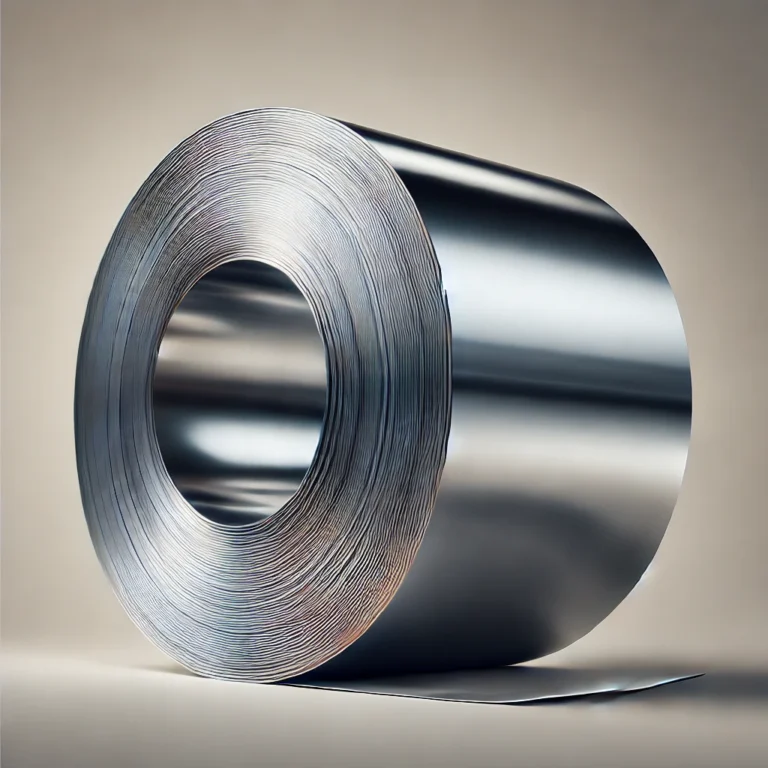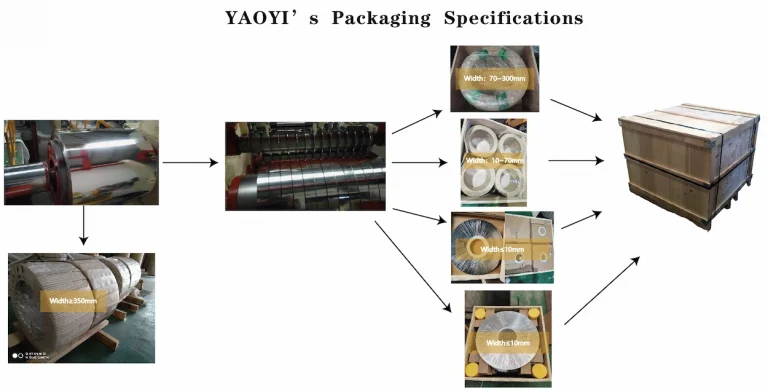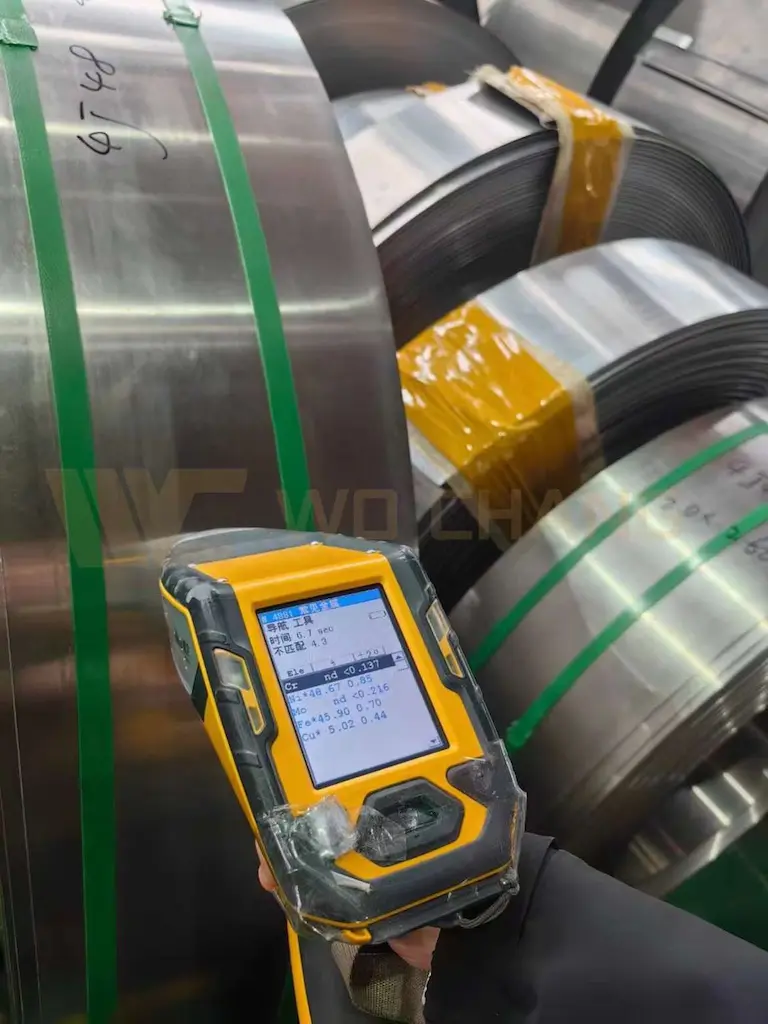AISI 301 properties is known for its austenitic stainless steel with a high work-hardening rate. It can be produced in strip and wire forms with tensile strengths of up to more than 1300 MPa, allowing it to be processed into tempers ranging from 1/16 Hard to Full Hard.
Using a controlled analysis, Yaoyi’s aisi 301 properties can maintain sufficient ductility in circumstances up to 1/2 Hard, allowing it to be roll or brake formed into aircraft structural components, architectural components, and, in especially, structural components for train cars.
Myriad’s aisi 301 properties ranging from 3/4 hard to full hard should be employed whenever excellent wear resistance and spring characteristics are required in components with basic form designs.


Myriad’s aisi 301 qualities have a range of attractive features that greatly contribute to its widely used in the manufacture of components and parts in a broad range of industries.
It is particularly resistant to corrosion due to its high chromium percentage. Chrome concentration of 10.5 percent or more makes stain greater than stones without chromium or any trace element approximately 200 times more corrosion-resistant.
Other beneficial features Yaoyi’s aisi 301 consumer characteristics include high strength and durability, high and low temperature resistance, increased manufacturing formability and ease of manufacture, poor maintenance, extended service lives, an appealing appearance and recycled and environmentally sound features. When stainless steel is in operation, treatment, coating or painting it is no longer essential to maintain it looking fine.
If you want greater ductility or if you’re welding heavier parts, Yaoyi’s aisi 301 properties with low carbon concentration is recommended. Other grades have a higher nitrogen component to compensate for the reduced carbon level.
Stainless Steel Rolls: Everything You Should Know – YAOYI Stainless Steel

Corrosion Resistance is a property of materials that resist corrosion.
Corrosion resistance is comparable to that of stainless steel 304. Excellent corrosion resistance of Yaoyi’s aisi 301 properties applications involving external exposure to mildly corrosive environments at room temperature or lower.
A Complete Guide to 304 Stainless Steel Strapping
Resistant to High Temperatures
It has great oxidative resistance when intermittent, up to 840 °C and continuous service to 900 °C, although it’s not generally utilized in this climate. If the temperature exceeds 400°C, the effects of work hardening rapidly vanish. The strength of the annealed aisi 301 is comparable at around 800°C.
When used in creep applications, a work hardened aisi 301 can even lose strength and become weaker than an annealed grade 301.
Always Provides You with the BEST Austenitic Stainless Steel Products
Treatment with High Temperatures
Heat to 1010-1120° C and cool down fast. Choose the bottom end of the range for intermediate rinsing. For this type of steel, thermal treatment is not an option.
In applications requiring high strength steel Yaoyi’s aisi 301 characteristics and its low carbon variants are used. As a result, the graded work hardens at a very quick pace of around 14 MPa/percent Ra, resulting in extraordinarily high achievables strengths from cold rolling and roll forming (a 14MPa increase in tensile strength every 1 percent reduction in cold works).
Austenite, subject to strain hardening, is at least partially transformed to martensite in the aisi 301 characteristics of Yaoyi.
Despite the high strengths achieved, the residual ductility is still adequate to cause severe cold deformation. Despite cold working, the grades are strongly attracted to a magnet, while they are non-magnetic in the rinsed state.
A Manufacturer of Stainless Steel Strips
Yaoyi’s aisi 301 properties have excellent features that are applicable to all standard procedures. Welds in aisi 301 must be annealed in order to achieve optimal corrosion resistance; however, this is not required in Grades 301L or 301N. Welding and post-weld annealing are both effective methods of removing excessive strength that has been produced by cold rolling.
When assembling cold-rolled aisi 301 components, spot welding is a frequent method of assembly. Because of the limited heat affected zone associated with this quick welding procedure, there is little change in the overall strength of the component as a result.
Not only are mechanical and chemical qualities significant, but so are other properties as well. There are a few more on the list below that are useful for a variety of different applications:
Actually, it is possible to recycle stainless steel in order to create new items. Due to the reduction in the amount of raw materials required and the reduction in the amount of trash produced, our steel requirements place less burden on our environment.
Furthermore, the non-biodegradable condition prevents it from harming natural resources because it does not break down and penetrate into soil or water reservoirs.
Due to the high machinability and workability of stainless steel it makes it easy for designers to construct complicated shapes and products. No special equipment is required to carry out laser cutting of stainless steel, CNC machining, bending, etc.
Non-toxic home chemicals such as detergent, soap, and cleaning liquids are ideal for cleaning stainless steel products. This keeps them appearing brand new for an extended period of time, extending their service life.
The end result is less waste, which makes the initially expensive purchase more than worthwhile in the long run.
Due to their high brilliance, stainless steel goods are an excellent choice for surfaces that are subjected to the elements. It is available in a number of colors and finishes, ranging from bright to matte. It can be brushed, etched, embossed, and colored to achieve a desired look.
Because stainless steel’s toughness and corrosion resistance, it is longevity for many competitors. In comparison with other materials in the life cycle cost comparison, steel is often the most cost-effective material because of its low maintenance requirements.
The ability of a material to attract a magnet is referred to as magnetic permeability. The austenitic grades of stainless steel are the only kind of stainless steel that are not magnetic. Austenitic steels other than 310 and 316 stainless steels can exhibit a small degree of magnetism when subjected to cold processing.
ASTM A240 Material: Applications and Classifications
In terms of stainless steel, there are a great variety of grades to choose from, each with its own set of characteristics. The qualities of an alloy might vary greatly depending on the alloying element that is used. It all boils down to the requirements of the application in order to identify the most appropriate and cost-effective alternative.
Chrome is the alloy element that differs from other metals in stainless steel. It gives steel its ‘stainless’ quality. The passive chrome oxide layer and the surface shield prevent oxygen from being diffused in the metal and therefore preventing the internal structure of the metal corrosion.
Because chromium oxide ions have a size similar to steel molecules, the two elements are strongly linked. Oxide ions can therefore remain tightly linked to the surface when they operate under normal conditions.
Hence, a minimum of 10.5 percent is required for a steel to be designated as “stainless.” However, it is usual practice to increase the amount of chromium used in order to boost corrosion resistance. A secondary function of chrome is that it stabilizes ferrite crystals in an alloy, which results in the production of a ferrite microstructure in the alloy.
AISI 301 Chemical Composition: Characteristics, Compounds,and Grades
To further improve corrosion resistance, nickel is used in the formulation. It also acts as an austenite stabilizer, causing the production of austenite to be induced.
Therefore, it is possible to get a totally austenitic structure by adding 8-9 percent of nickel, which results in outstanding welding capabilities. Increased nickel content results in improved workability and corrosion resistance when the percentage of nickel is increased.
Copper also serves as an austenite stabilizer, which increases the properties of corrosion resistance and work-hardening, among other things.
In addition, it manufactures stainless steel goods that are suited for use in cold working circumstances, which are required while working with screws and nails.
Increasing the material resistance to highly concentrated nitric and sulphuric acids with silicon into the stainless steel system. It also causes the development of ferrite, which makes the metal more oxidation resistant.
Nitrogen is an austenite stabilizer that strengthens the resistance and localization of the material to corrosion. Localized corrosion is known as localised corrosion in a variety of localized corrosion for example pitting corrosion, crevice corrosion and intergranular corrosion.
The use of molybdenum and tungsten enhances corrosion resistance both in general and in specific areas. Because the former is a ferrite stabiliser, it needs to be balanced with austenite stabilisers when employed in austenite alloys to retain the composition of the austenite phase.
Take note that when molybdenum is added to martensitic stainless steel, it also helps to increase the material’s high-temperature strength. The addition of tungsten in conjunction with molybdenum enhances the above-mentioned qualities as well.
In stainless steel, manganese improves the qualities of strength, toughness, and hardenability by acting as a strengthening agent. The inclusion of manganese improves the performance of the metal when subjected to high temperatures.
Manganese helps in the solution of nitrogen in steel, and so it can be utilized in the production of stainless steel to replace nickel with nitrogen.
In addition to the typical features of steel, the corrosion and heat resistance are therefore two additional advantages of stainless steel. It gives all the benefits of steel and a number of further benefits. It is less susceptible to corrosion, can stand more difficult circumstances and has a longer life span.
However, to say it’s stain-proof isn’t completely right. Above all, depending on the grade the resistance to corrosion varies. Unhealthy environmental circumstances, such as low oxygen levels, low circulation and high salinity, might however lead it to discolor permanently.
Although it has the risks outlined above, steel has a wonderful effect on the production industry as a whole. In this respect, it is a wonderful material. Because of the enormous variety of different grades, each with a unique set of features, there is always an excellent grade for a particular application. To achieve cost-effective investment, it is vital to make an informed decision on the grade.
AISI 301 Equivalent: Components, Processing, and Applications
Physical Properties
Most of the time, the advantages provided by physical features such as corrosion resistance are the driving force behind the selection of stainless steel.
All stainless steels are characterized by their excellent resistance to corrosion. Under typical conditions, low alloy grades can tolerate corrosion. In presence of most acids, alkaline solutions and chloride conditions, higher alloys are resistant to corrosion.
The high chromium concentration in stainless steels helps them resistant to corrosion. Overall, stainless steel has at least 10.5% chromium and a maximum of 15%. The chromium in the alloy produces a self-healing transparent protective oxide layer which is spontaneous when the alloy has been heated in the presence of air.
Because of the self-healing properties of the oxide layer, the corrosion resistance remains unchanged regardless of the production method used. Even if the surface of the material is sliced or damaged, it will self-heal and its corrosion resistance will be maintained over time.
Temperature Resistance
Some varieties of stainless steel can tolerate scaling and keep good strength even if the temperature is exceedingly high. Although susceptible to extremely low temperatures, other grades retain their exceptional mechanical properties.
Fabrication Techniques
The most common grades of stainless steel, for example carbon and alloy steel, can be cut, welded, formed or machined and manufactured using the same techniques and equipment as other kinds of steel.
AISI 301 Stainless Steel Properties
The designs and manufacturing techniques of the components may be adjusted to benefit from the harding process in stainless steels when cold work is performed. The thinner materials can be used due to the high strengths resulting in lower weights and overall costs.
Heat treatment can be used to strengthen the strength of other stainless steels.
AISI 301 stainless steel belongs to the austenitic stainless steel family and is known for its high tensile strength and excellent corrosion resistance. This alloy contains a high amount of chromium and nickel, allowing it to maintain non-magnetic properties while offering increased strength through cold working.
This material is commonly used in automotive trims, aerospace components, and industrial equipment due to its combination of strength and flexibility. Compared to SS 304, AISI 301 is more likely to harden during processing, making it suitable for applications requiring extra durability.
The AISI 301 chemical composition includes the following elements in precise quantities, contributing to its unique mechanical behavior and corrosion resistance:
This composition gives AISI 301 stainless steel a balance between strength and flexibility, making it ideal for components exposed to harsh environmental conditions or repetitive stress.
When annealed, AISI 301 stainless steel exhibits improved ductility, which allows the material to undergo significant deformation without cracking. Annealing also softens the material, reducing internal stresses from prior cold working processes. Typical properties in the annealed condition include:
Annealing makes 301 stainless steel suitable for forming and bending processes while maintaining a certain level of corrosion resistance. In industrial settings, annealed SS 301 is used for intricate parts such as springs and fasteners that need enhanced ductility.
Stainless Steel Foil Roll – The Ultimate Guide
Though SS 301 vs 304 are both part of the austenitic family, there are notable differences in their mechanical performance:
These distinctions guide engineers in selecting the appropriate material based on mechanical and environmental requirements.